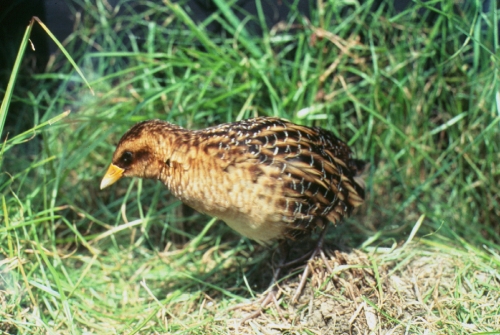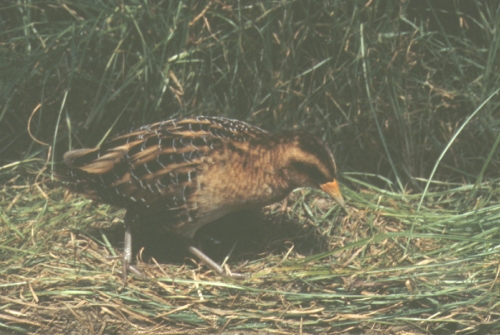Plants and Animals
Coturnicops noveboracensis Yellow rail
Key Characteristics
Although rarely seen, this secretive small rail is approximately 6-7.5 inches (15-19 cm) in length, with a 10-13 inch (25-33 cm) wingspan. It is tawny yellow above and is streaked with wide dark stripes crossed by white bars. When flushed its flight pattern appears weak. In flight a pronounced white wing patch on the trailing edge of its wings is a distinctive identification character along with its short wings, stocky body, short tail and dangling legs. The Yellow Rail is most often identified by its rhythmic metallic ticking call given in an alternating series of "tic tic, tic tic tic" that resembles the sound of a typewriter or two stones being tapped together.
Status and Rank
US Status: No Status/Not Listed
State Status: T - Threatened (legally protected)
Global Rank: G4 - Apparently secure
State Rank: S2 - Imperiled
Occurrences
| County | Number of Occurrences | Year Last Observed |
|---|---|---|
| Alger | 1 | 2009 |
| Chippewa | 4 | 2016 |
| Delta | 1 | 2007 |
| Luce | 1 | 1981 |
| Mackinac | 2 | 2004 |
| Roscommon | 1 | 2005 |
| Schoolcraft | 1 | 1982 |
Information is summarized from MNFI's database of rare species and community occurrences. Data may not reflect true distribution since much of the state has not been thoroughly surveyed.
Habitat
In Michigan, Yellow rails are very closely associated with Carex lasiocarpa, a type of sedge found in northern wet meadows.
Natural Community Types
For each species, lists of natural communities were derived from review of the nearly 6,500 element occurrences in the MNFI database, in addition to herbarium label data for some taxa. In most cases, at least one specimen record exists for each listed natural community. For certain taxa, especially poorly collected or extirpated species of prairie and savanna habitats, natural community lists were derived from inferences from collection sites and habitat preferences in immediately adjacent states (particularly Indiana and Illinois). Natural communities are not listed for those species documented only from altered or ruderal habitats in Michigan, especially for taxa that occur in a variety of habitats outside of the state.
Natural communities are not listed in order of frequency of occurrence, but are rather derived from the full set of natural communities, organized by Ecological Group. In many cases, the general habitat descriptions should provide greater clarity and direction to the surveyor. In future versions of the Rare Species Explorer, we hope to incorporate natural community fidelity ranks for each taxon.
Management Recommendations
Prescribed fire has been used successfully in northern Michigan as a management tool to rejuvenate sedge growth, limit woody growth and impede the establishment of boreal flora such as sphagnum moss. Rotational burning has ensured that some suitable habitat is available in a given year at each marsh. Marginal water level changes in seasonal and annual water depths are natural but ditching or altering water flows (which result in drier habitats) and diking and flooding areas have negative effects on the preferred microhabitat structure. Manipulation of water levels on refuges to benefit migratory waterfowl could adversely affect yellow rails if the objective is to provide deepwater marshes. Retention of wet sedge meadows as a component of marsh habitat is essential to maintenance of Yellow rail populations. Since this species is dependent on transitory habitats, this suggests that it can colonize new sites as they become available. Thus, management and protection of occupied as well as unoccupied, potentially suitable habitat throughout the state, is crucial for the long-term survival of the Yellow rail in Michigan.
Active Period
Migration from fourth week of April to third week of May
Migration from third week of August to fourth week of September
Nesting from third week of May to third week of July
Survey Methods
Although some observers have reported hearing intermittent calls during the day, calling is most incessant and pronounced at night usually beginning after total darkness. The best method for surveying this elusive bird is to visit suitable habitat on nights with little or no wind or rain and to listen for its call. Surveys conducted on clear nights with minimal cloud cover yield the best results. If the Yellow rail is not detected initially, the surveyor can imitate its call by tapping two stones (or two quarters) together or use a playback recording of its call and then listen for a response.
Listen for call
Survey Period: From third week of May to third week of July
Time of Day: Night
References
Survey References
- Bibby, C.J., N.D. Burgess, and D.A. Hill. 1992. Bird Census Techniques. Academic Press, New York.
Technical References
- Evers, D.C. 1994. Endangered and Threatened Wildlife of Michigan. The University of Michigan Press, Ann Arbor. 412pp.
- Hyde, D. 2001. Special Animal Abstract for Coturnicops novaboracencis (Yellow rail). Michigan Natural Features Inventory, Lansing, MI. 4pp.




